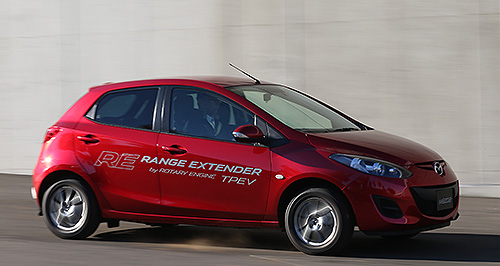Make / Model Search
News - MazdaMazda confirms rotary range extender for 2019It’s back: A rotary engine could still power a future Mazda sportscar based on the RX-Vision (left) down the track, but it is likely to resurface as a range extender in a more conventional small car first. New lease of life for Mazda rotary as auxiliary battery pack charger for future EV4 Sep 2017 By BYRON MATHIOUDAKIS in FRANKFURT MAZDA has at last confirmed that the Wankel rotary engine will make a production car comeback in less than 18 months, but it will be used as a range extender for an upcoming hybrid electric vehicle (EV) rather than powering a replacement for the RX-8 sportscar. To be announced in the first half of 2019, the newly developed rotary engine is understood to have no physical connection to the driving wheels in its freshly minted role as an EV distance enhancer, serving instead only as a top up for the battery pack, similar to how a tiny motorcycle engine under the cargo area of the BMW i3 REx Range Extender is used. The revelation was made to Australian journalists in Germany last week by Mazda Motor Corporation director and senior managing executive officer with oversight for research and development, Kiyoshi Fujiwara. “Mazda is developing an EV model by ourselves for 2019,” he said. “It will be available with a rotary range extender.” It follows months of speculation after MMC Europe’s research and development manager, Matsuhiro Tanaka, revealed to English publication Auto Express hinted at such a vehicle at this year’s Geneva motor show. While details are scant, it is believed that the range extender is a development of the 16-X 1.6-litre rotary engine project, highlighting the scalable flexibility of the engine family, from electric vehicle distance booster to the heart of a future high-performance sportscar, previewed by the RX-Vision concept that stole the 2015 Tokyo motor show. The rotary-assisted range-extender EV in question may be a derivation of the next-generation Mazda3, which will debut an all-new architecture that has been developed to accommodate electrification in various forms. However, European media has reported that the smaller Mazda2/Demio light car could also receive the Wankel-powered enhancer, as its lighter mass maximises the EV powertrain’s efficiency. Adding weight to the smaller hatch theory is the fact that Mazda showed off a Mazda2/Demio Range Extender prototype back in late 2013 in Japan. That employed a 330cc rotary unit charging up a set of lithium-ion batteries powering a 75kW electric motor driving the front wheels, for a 400km range – double that of the limited-run Demio EV released in 2011 operators of the latter vehicle told Mazda of their “dissatisfaction” with the limited range, prompting the rotary concept. It is also worth noting that the best-selling car in Japan this year has been the Mazda2-sized Toyota Aqua hybrid, also known in Australia as the Prius C. It is understood that there is no relationship between Mazda’s rotary engine range extender and the unit Audi experimented with at the beginning of this decade with the A1 e-tron hatchback. A single-rotor unit with a 254cc capacity, the German Wankel ran at a constant 5000rpm to deliver 15kW of charge to lithium-ion batteries.  Read more18th of November 2016  LA show: ‘Fundamental’ issues delay rotary returnMazda executive says born-again rotary is presenting more challenges than expected23rd of June 2016  RX-Vision previews new wave of Mazda modelsNew Mazda design creed takes hold while rotary work continues as priority over MPS8th of April 2016  Mazda patents next-generation rotary enginePatent files surface for Mazda’s new potentially mass production rotary engine2nd of November 2015  Tokyo show: Mazda ‘needs’ hi-po sportscarMazda Australia hopes to add sexy rotary sportscar to its roster |
Click to shareMazda articlesResearch Mazda Motor industry news |











Facebook Twitter Instagram